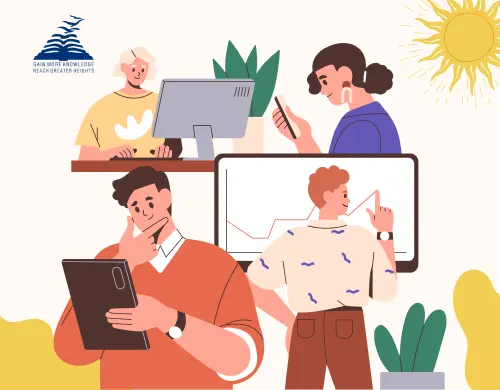Students’ academic journey is often made more enjoyable and effective when they study in a group. A well-organized study group can foster collaboration, improve understanding, and inspire motivation.
Here at the Presidency Group of Schools, we understand the value of effective study groups as a means of enhancing students’ learning. Here are some strategies for creating a successful study group.
The Benefits of Student Collaboration
Activities that are social, active, relevant, interesting, and owned by the students help them learn more deeply. Collaborative learning has many benefits, such as:
- Building up skills like critical thinking, speaking, managing oneself, and being a leader.
- Encouraging interactions between students and faculty.
- Increased self-esteem , responsibility, and student retention.
- Having access to and learning more about different points of view.
- Getting ready for social and work situations that will happen in real life.
Obstacles to Student Collaboration
No doubt, collaborative learning has various benefits but it also comes with obstacles that students face.
- Some students may feel shy or intimidated by their peers. Others may not have access to the necessary technology or resources. some students may not have the same learning goals or interests as their peers.
- Having difficulty communicating with other students. Not feeling comfortable discussing topics that are controversial. Fear of public speaking or criticism.
- Unequal participation within collaboration
- To avoid scheduling problems, use tools that let everyone in the group enter their availability. This will make it easier to find times for meetings.
- Saying openly about the problem and encouraging them to contribute should be done if some members are consistently less involved.
- Differences of opinion may appear within the group. Encourage a positive response by giving everyone a chance to share their thoughts and find common ground.
8 Strategies for Building Student Collaboration
Set Your Goals:
- Make your study goals very clear. How would you like the study group to go over those subjects?
- Find out how often and for how long the study group will meet.
- Choose members who are compatible with you.
- Pick people to study with who are reliable, motivated, and genuinely interested in the things you will be learning.
Size of group:
- Four to five people are usually the best group size for working together to learn. The size of the group depends on what the task is and how big it is.
- If the group is too small, there will not be enough different points of view and styles of interaction, which is what collaborative learning is supposed to avoid. When there are too many people, things can get out of hand, and some people may withdraw while others take charge of the activities. Make sure you have enough trustworthy people.
Assign Roles:
- Sharing responsibilities with others is an important part of learning together.
- Based on the students’ personalities and patterns of behaviour, roles can be given to them.
Make a schedule:
- Come up with a study schedule that works for everyone in the group.
- Be sure that everyone is on the same page by using digital tools or apps to manage and share the study schedule.
Taking part actively:
- Encourage everyone in the group to take an active role. Avoid passive ways of learning, like just listening to one person talk.
- Make sure that everyone has a chance to lead and contribute by switching who leads the discussion.
A good communication strategy:
- Encourage the group to talk to each other in an open and polite way. Get people to ask questions and talk.
- Between meetings, use digital platforms to talk to each other and share resources.
Analyse progress:
- Assess your study group’s progress and effectiveness on a regular basis. Are you achieving your targets? Are there things that could be better?
- Change or adjust how you study with your group based on what you learn.
Celebrate Your Successes:
- Celebrate and acknowledge the group’s successes, whether they are mastering a tough idea or getting good grades on a test.
- Everyone can be motivated to keep working together well with positive reinforcement.
How Presidency Schools Can Help Facilitate Student Collaboration
The Presidency Group of Schools, renowned for their commitment to holistic education, plays a pivotal role in fostering student collaboration. We are equipped with educators who understand the significance of collaborative learning and actively integrate strategies to promote it.
- Presidency schools often prioritise the development of a positive classroom culture where students feel a sense of belonging and are encouraged to share diverse perspectives.
- The curriculum is carefully crafted to include collaborative projects and activities that challenge students to work together, building essential teamwork and communication skills.
- With a focus on personalised learning, presidency schools recognise the importance of adapting strategies to accommodate different learning styles, ensuring that each student can actively participate in collaborative endeavours.
Conclusion
It takes careful planning, organisation, and active participation from everyone in the study group for it to work. When done right, study groups can make learning a lot more fun, increase drive, and help students do better in school. At Podar International School, we encourage students to look into how study groups can help them learn together. Students can make study groups that are both useful and fun by using these tips and dealing with problems as they come up.
Always keep in mind that the main goal is to better understand the subject and form good study habits that will help you all the way through school.







